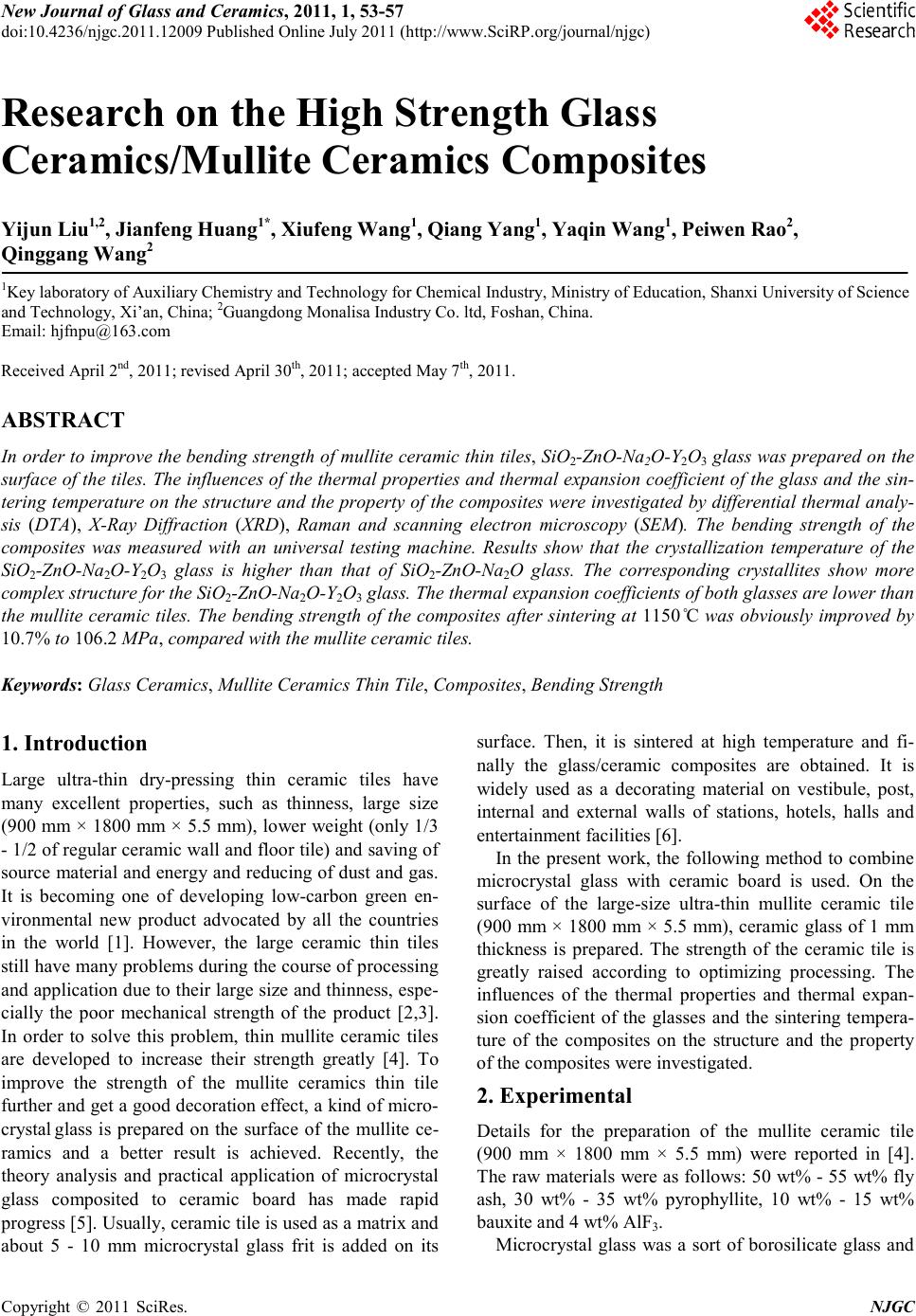
New Journal of Glass and Ceramics, 2011, 1, 53-57
doi:10.4236/njgc.2011 .12009 Published Online July 2011 (http://www.SciRP.org/journal/njgc)
Copyright © 2011 SciRes. NJGC
Research on the High Streng t h Glass
Ceramics/Mullite Ceramics Composites
Yijun Liu1,2, Jianfeng Huang1*, Xiufeng Wang1, Qiang Yang1, Yaqin Wang1, Peiwen Rao2,
Qinggang Wang2
1Key laboratory of Auxiliary Chemistry and Technology for Chemical Industry, Ministry of Education, Shanxi University of Science
and Technology, Xi’an, China; 2Guangdong Monalisa Industry Co. ltd, Foshan, China.
Email: hjfnpu@163.com
Received April 2nd, 2011; revised April 30th, 2011; accepted May 7th, 2011.
ABSTRACT
In order to improve the bending strength of mullite ceramic thin tiles, SiO2-ZnO-Na2O-Y2O3 glass was prepared on the
surface of the tiles. The influences of the thermal properties and thermal expansion coefficient of the glass and the sin-
tering temperature on the structure and the property of the composites were investigated by differential thermal analy-
sis (DTA), X-Ray Diffraction (XRD), Raman and scanning electron microscopy (SEM). The bending strength of the
composites was measured with an universal testing machine. Results show that the crystallization temperature of the
SiO2-ZnO-Na2O-Y2O3 glass is higher than that of SiO2-ZnO -Na2O glass. The corresponding crystallites show more
complex structure for the SiO2-ZnO-Na2O-Y2O3 glass. The thermal expansion coefficients of both glasses are lower than
the mullite ceramic tiles. The bending strength of the composites after sintering at 1150˚C was obviously improved by
10.7% to 106.2 MPa, compa red with the mullite ceram ic tiles.
Keywords: Glass Ceramics, Mullite Ceramics Thin Tile, Compo si tes, Bending Strength
1. Introduction
Large ultra-thin dry-pressing thin ceramic tiles have
many excellent properties, such as thinness, large size
(900 mm × 1800 mm × 5.5 mm), lo wer weight (only 1/3
- 1 /2 of regular c eramic wall and floor tile) and sa ving o f
sourc e mater ial a nd ener gy an d red ucing of d ust a nd gas.
It is becoming one of developing low-carbon green en-
vironmental new product advocated by all the countries
in the world [1]. However, the large ceramic thin tiles
still have ma ny pr ob lems d uri ng the co urse of pr ocessing
and application due to their large size and thinness, espe-
cially the poor mechanical strength of the product [2,3].
In order to solve this problem, thin mullite ceramic tiles
are developed to increase their strength greatly [4]. To
improve the strength of the mullite ceramics thin tile
further and get a good decoration effect, a kind o f mic ro-
crystal glass is prepared on the surface of the mullite ce-
ramics and a better result is achieved. Recently, the
theory analysis and practical application of microcrystal
glass composited to ceramic board has made rapid
progress [5]. Usually, ceramic tile is u sed as a matri x and
about 5 - 10 mm microcr ystal glass frit is added on its
surface. Then, it is sintered at high temperature and fi-
nally the glass/ceramic composites are obtained. It is
widely used as a decorating material on vestibule, post,
internal and external walls of stations, hotels, halls and
entertain ment facilities [6] .
In the present work, the following method to combine
microcr ystal glass with ceramic board is used. On the
surface of the large-size ultra-thin mullite ceramic tile
(900 mm × 1800 mm × 5.5 mm), ceramic glass of 1 mm
thickness is prepared. The strength of the ceramic tile is
greatly raised according to optimizing processing. The
influences of the thermal properties and thermal expan-
sion coefficient of the glasses and the sintering tempera-
ture of the composites on the structure and the property
of the composites were investigated.
2. Experimental
Details for the preparation of the mullite ceramic tile
(900 mm × 1800 mm × 5.5 mm) were reported in [4].
The raw materials were as follows: 50 wt % - 55 wt% fly
ash, 30 wt% - 35 wt% pyrophyllite, 10 wt % - 15 wt%
bauxite a nd 4 wt% AlF3.
Microcrystal glass was a sort of borosilicate glass and